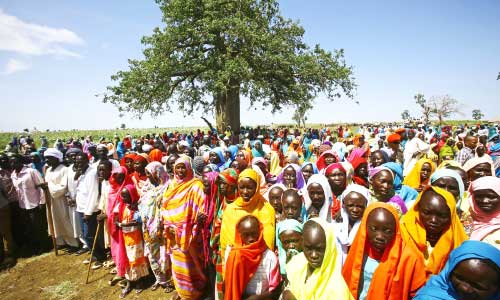Over 30,000 people in South Sudan’s war-zone regions face death by starvation, the United Nations said Thursday, warning that tens of thousands more are on the brink of famine.
While an official famine has not been declared, the report describes the worst conditions yet seen in a 22-month civil war marked by atrocities and accusations of war crimes, including the blockading of food supplies.
‘At least 30,000 people are living in extreme conditions and are facing starvation and death,’ the UN’s Food and Agriculture Organization (FAO), the UN children’s agency UNICEF and the World Food Programme (WFP) said in a joint statement.
Those worst affected are in the northern battleground state of Unity, once the country’s key oil producing region, but now scene of some of the heaviest fighting, including the mass abduction and rape of women and children.
Some 3.9 million people are in crisis – a third of the country’s population – a massive 80 per cent rise compared to the same period last year, the UN said.
Famine is a technical measure, assessed by the Integrated Food Security Phase Classification (IPC), which classifies hunger on a scale of one to five.
An IPC report released Thursday warned that without ‘urgent and immediate humanitarian access’, the situation was ‘likely to deteriorate into famine’.
While large parts of South Sudan’s Unity and Upper Nile regions were already classified as being just one step short of famine, termed ‘Emergency’ or ‘phase four’, areas in Unity have been declared to be in ‘phase five’ for the first time.
Level five is classified as ‘Catastrophe’, and when stretched to 20 per cent of the population, becomes famine.
‘Since the war in South Sudan started nearly two years ago, it is the first time that an IPC analysis has found any parts of the population in phase five, ‘Catastrophe’,’ the UN added.
Conditions on the ground for affected individual households are therefore already effectively in famine conditions.
While poor rains have impacted harvests in some areas, the worst conditions are in war-zone areas, with the extreme conditions sparked by conflict not climate.
Hardest hit are the counties of Leer, Guit, Koch and Mayendit, areas where aid agencies have been forced to pull out in recent months.
While an official famine has not been declared, the report describes the worst conditions yet seen in a 22-month civil war marked by atrocities and accusations of war crimes, including the blockading of food supplies.
‘At least 30,000 people are living in extreme conditions and are facing starvation and death,’ the UN’s Food and Agriculture Organization (FAO), the UN children’s agency UNICEF and the World Food Programme (WFP) said in a joint statement.
Those worst affected are in the northern battleground state of Unity, once the country’s key oil producing region, but now scene of some of the heaviest fighting, including the mass abduction and rape of women and children.
Some 3.9 million people are in crisis – a third of the country’s population – a massive 80 per cent rise compared to the same period last year, the UN said.
Famine is a technical measure, assessed by the Integrated Food Security Phase Classification (IPC), which classifies hunger on a scale of one to five.
An IPC report released Thursday warned that without ‘urgent and immediate humanitarian access’, the situation was ‘likely to deteriorate into famine’.
While large parts of South Sudan’s Unity and Upper Nile regions were already classified as being just one step short of famine, termed ‘Emergency’ or ‘phase four’, areas in Unity have been declared to be in ‘phase five’ for the first time.
Level five is classified as ‘Catastrophe’, and when stretched to 20 per cent of the population, becomes famine.
‘Since the war in South Sudan started nearly two years ago, it is the first time that an IPC analysis has found any parts of the population in phase five, ‘Catastrophe’,’ the UN added.
Conditions on the ground for affected individual households are therefore already effectively in famine conditions.
While poor rains have impacted harvests in some areas, the worst conditions are in war-zone areas, with the extreme conditions sparked by conflict not climate.
Hardest hit are the counties of Leer, Guit, Koch and Mayendit, areas where aid agencies have been forced to pull out in recent months.
Source: New Age










